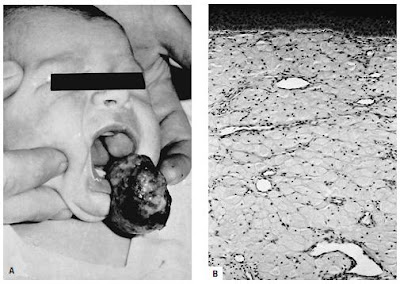The granular cell tumor is an important oral hamartomatous lesion (1) because of its frequent occurrence as a nodule on the tongue and as its variant form on the gingiva (congenital epulis) (Figure 7-12) or other mucosal site; (2) because of the controversy as to its nature and cytologic structure; and (3) because of the overlying pseudoepitheliomatous hyperplasia that often leads to a misdiagnosis of squamous cell carcinoma and to unnecessary radical surgery.Histologically, these lesions are composed of masses of large eosinophilic granular
immunologically reactive for S-100 protein and myelin but negative for myogenous and histiocytic markers and that they are probably derived from Schwann cells or their mesenchymal precursors.
Quite innocent-looking and often long-standing tongue nodules in biopsy specimens from adults may turn out to be granular cell tumors. Treatment of these oral lesions, both on the tongue and in extralingual locations, is by local excision. The differential diagnosis for congenital epulis includes other hamartomatous and hyperplastic oral mucosal lesions, odontogenic tumors, and ectopic tooth germs. Multiple and familially occurring oral granular cell tumors have been reported on several occasions. In contrast to the prevalence of the granular cell tumor, true neoplasms of the muscle of the body of the tongue (rhabdomyoma) are exceedingly rare and are positive for myogenous markers.
Quite innocent-looking and often long-standing tongue nodules in biopsy specimens from adults may turn out to be granular cell tumors. Treatment of these oral lesions, both on the tongue and in extralingual locations, is by local excision. The differential diagnosis for congenital epulis includes other hamartomatous and hyperplastic oral mucosal lesions, odontogenic tumors, and ectopic tooth germs. Multiple and familially occurring oral granular cell tumors have been reported on several occasions. In contrast to the prevalence of the granular cell tumor, true neoplasms of the muscle of the body of the tongue (rhabdomyoma) are exceedingly rare and are positive for myogenous markers.

